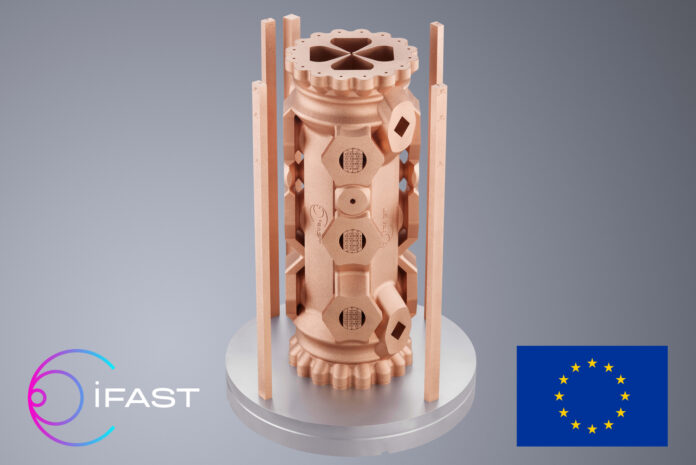If you read this article, you may have seen a pure-copper accelerator component produced using AM as part of the EU-funded I.FAST project coordinated by CERN. I.FAST which stands for Innovation Fostering in Accelerator Science and Technology, focuses on the use of metal AM to foster Europe’s leadership in particle accelerators for science and society.
This component is a radio frequency quadrupole (RFQ), one of the most complex parts of any accelerator complex. It provides energy to the beam of particles bringing them it ever close to speed of light.
According to Maurizio Vretenar from CERN, project coordinator of I.FAST, “over 30 000 accelerators are currently in use worldwide, the large majority of which is used for healthcare, and industry. Additive manufacturing can help reduce the size and cost of all accelerators types, by improving and shortening their fabrication and enhancing their performance.”
The traditional manufacturing process of this RFQ usually involves several production steps such as milling and brazing. Furthermore, it is usually fabricated in various parts that are thereafter assembled. AM removes these steps and even allows for the production of the component in one go.
“This is proof that large copper components with a component height of nearly 400 millimeters can be manufactured additively with sufficient precision using our machines – or in other words: with 3D printing, we can manufacture even high-precision parts like this faster, cheaper and more energy-efficiently,” says Michael Thielmann, additive manufacturing expert at TRUMPF. The high-tech company will show the particle accelerator component at the leading 3D printing trade show Formnext in Frankfurt in November.
I.FAST team of experts from CERN, Politecnico de Milano, CNRS-IN2P3, Fraunhofer IWS and Riga Technical University designed the complex component specifically for TRUMPF’s TruPrint 5000 green edition. With the TRUMPF system for instance, it is possible to build around empty spaces such as cooling channels when printing the RFQ. “Thanks to the green laser, we can print even the finest copper structures at a high and consistent quality, with increased productivity,” says Thielmann.
Moreover, the production with green laser would be faster for additive manufacturing of copper components than comparable systems with infrared technology. The copper absorbs the green laser beam better than that of an infrared laser, making it easier to process. “We need less energy to be as fast as an infrared laser, or we can work faster with the same energy,” Thielmann says. As a result, users can additively manufacture copper components more cheaply with the green laser.
Remember, you can post job opportunities in the AM Industry on 3D ADEPT Media free of charge or look for a job via our job board. Make sure to follow us on our social networks and subscribe to our weekly newsletter : Facebook, Twitter, LinkedIn & Instagram ! If you want to be featured in the next issue of our digital magazine or if you hear a story that needs to be heard, make sure you send it to contact@3dadept.com






